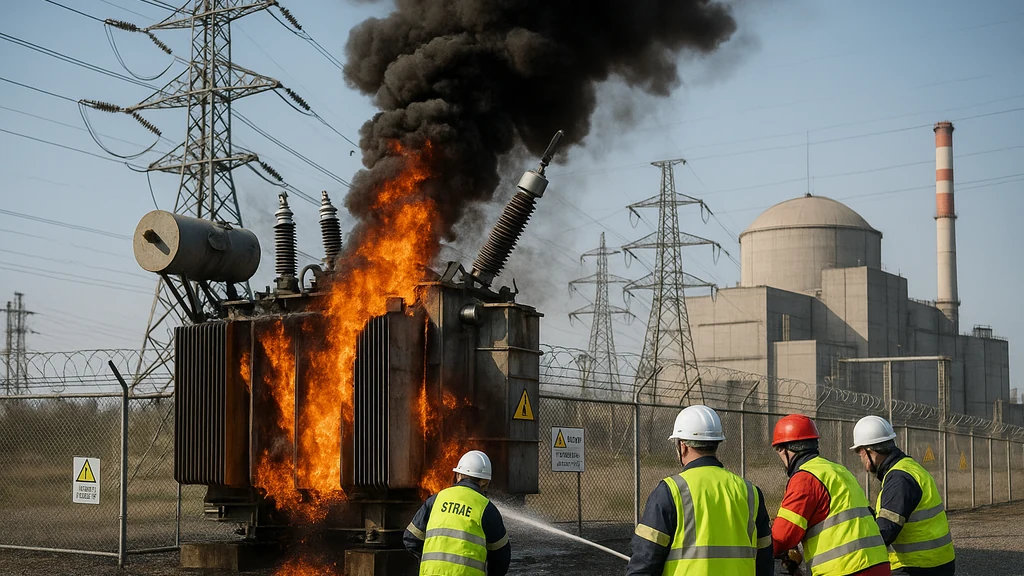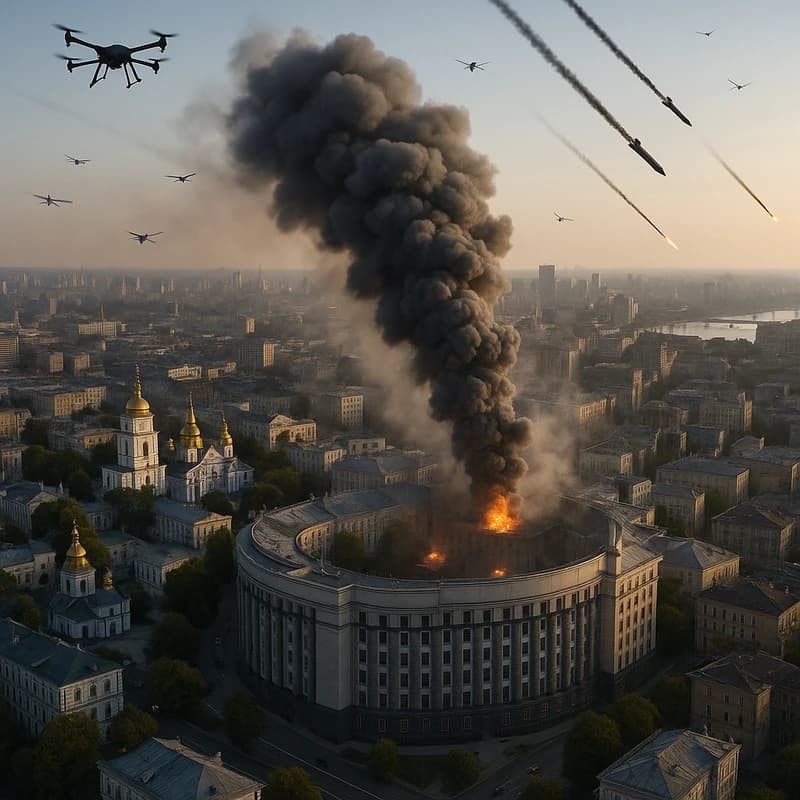Kursk nuclear power plant drone strike damaged a transformer and cut Reactor No. 3 output, but authorities say radiation levels are normal. Stay updated.
Quick Answer
A Ukrainian drone strike damaged an auxiliary transformer at Russia’s Kursk Nuclear Power Plant, sparking a fire and causing reactor No. 3 to halve output. Authorities and the IAEA say radiation levels remain normal, with no leak detected. The incident follows Independence Day strikes on energy infrastructure across Russia, prompting oil-market nerves and renewed focus on nuclear-safety protections around sensitive sites. Key takeaway: the Kursk nuclear power plant drone strike raises serious nuclear-safety questions even when radiation remains within normal limits.
Complete Guide to Kursk nuclear power plant drone strike
What happened at the Kursk nuclear power plant?

- In the hours after Ukraine-marked Independence Day, a Ukrainian drone strike targeted Kursk and damaged an auxiliary transformer at the Kursk Nuclear Power Plant. The fire that erupted at the site prompted operators to halve the output of reactor No. 3 as a precaution while crews worked to contain the blaze and secure the facility. The incident drew rapid scrutiny from global watchdogs, with the IAEA noting the importance of safeguarding nuclear sites amid elevated hostilities. Intercepted drones were reported across more than a dozen Russian regions, signaling a broad, intensified attack pattern around critical infrastructure.
- The Kursk NPP event sits within a larger pattern of attacks aimed at energy and industrial facilities in Russia in the weeks around the holiday period, reinforcing concerns about the resilience of critical infrastructure in wartime.
- Key takeaway: the Kursk nuclear power plant drone strike demonstrates how military actions near sensitive energy sites can trigger operational adjustments and international safety questions, even when radiation readings do not indicate a leak.
Did Kursk nuclear plant have a radiation leak?
- According to authorities and the IAEA, there was no radiation leak and radiation levels remain normal. Officials emphasized that monitoring showed background or typical levels, with no abnormal rise despite the fire and the damage to infrastructure at Kursk. This distinction between physical damage and radiological release matters: a fire can threaten cooling or safety systems, while a leak would have broader radiological implications.
- The contrast between visible damage (a transformer fire, reduced reactor output) and the absence of radiation spikes shapes how international bodies assess risk and communicate with the public in near-real-time crises.
- Key takeaway: the Kursk nuclear power plant drone strike produced significant logistical disruption without a detectable radiological release, underscoring the importance of rapid, independent monitoring during such events.
What did the IAEA say about the Kursk incident?
- The IAEA reiterated that nuclear facilities must be protected at all times and emphasized ongoing monitoring and transparency. While confirming that radiation levels remained normal, the IAEA called for heightened safety measures around sensitive sites amid escalating attacks near critical infrastructure. The agency’s stance reflects a broader insistence on defensive security arrangements and robust incident reporting in conflict contexts.
- Analysts note that IAEA statements serve as a bellwether for international confidence in nuclear safety norms, especially when battles threaten proximity to reactors, spent-fuel pools, or auxiliary power systems.
- Key takeaway: the IAEA’s response underscores the global insistence that nuclear facilities operate with stringent safeguards and clear communication channels during heightened security risks.
Why did Ukraine target Kursk nuclear plant?
- Ukraine has framed deep strikes as efforts to degrade Russia’s war logistics, disrupting command-and-control, transport routes, and energy-supply chains that enable Moscow’s operations. Attacks on the Kursk nuclear power plant, if executed with the explicit aim of pressuring Russia’s energy resilience, fit into a broader tactic of targeting critical infrastructure to complicate Russian wartime logistics.
- Kyiv and its allies argue that such strikes are part of a broader strategy to degrade an adversary’s ability to sustain long-term military campaigns, while international observers caution about escalatory dynamics and civilian-safety considerations near nuclear facilities.
- Key takeaway: Ukraine’s targeting of Kursk, if pursued as a strategic disruption tactic, illustrates how infrastructure-centered warfare intersects with nuclear-safety challenges and international risk management.
What is the status of reactor No. 3 at Kursk?
- Reactor No. 3 reduced its output following the transformer fire, reflecting a precautionary step to protect cooling and safety systems. There have been no reports of damage to reactor fuel or coolant systems, and authorities indicate cooling functions remain under control as responders continue to isolate the incident and assess electrical feed and infrastructure integrity.
- The immediate operational impact is containment-focused, not a declaration of permanent shutdown. Updates from the plant operator and regulators are expected as repair teams work through transformer replacements or repairs and audit the facility’s resilience against further incidents.
- Key takeaway: Reactor No. 3’s output reduction signals a cautious, safety-first response, with overall nuclear safety preserved as the situation is evaluated and repairs proceed.
Were other Russian energy facilities attacked recently?
- Fires and incidents have been reported at other energy infrastructure in the broader wave of strikes, including reports of damage at Novatek’s Ust-Luga terminal. The pattern of attacks across multiple sectors—oil, gas, and electricity—on top of the Kursk event broadens concerns about supply-chain risks in Russia and the potential ripple effects on global energy markets.
- Intercepted drones across more than a dozen regions suggest a coordinated, wide-ranging effort to disrupt energy logistics, complicating both domestic energy management and international market expectations.
- Key takeaway: the Kursk incident sits within a larger cluster of infrastructure-targeting actions that raise questions about resilience, risk management, and international energy-market reactions.
How did the Kursk incident affect energy markets?
- Markets responded to a broader set of strikes on Russian infrastructure with oil trading higher on supply-risk concerns. While the Kursk event itself is a single incident, the surrounding context—attacks on pipelines, terminals, and power facilities—amplified risk premiums in energy trading and added volatility to the energy complex.
- Analysts highlight that the psychological and logistical dimensions of these strikes can matter as much as immediate physical damage: traders weigh disruption probabilities, potential backup supply routes, and geopolitical signals.
- Key takeaway: the Kursk nuclear power plant drone strike contributed to a mood of heightened risk around energy supplies, influencing crude benchmarks and downstream price dynamics due to perceived reliability and security challenges.
What are the nuclear safety implications of attacks near nuclear plants?
- Attacks near nuclear sites test the integrity of emergency response planning, physical security, and public communication. Even when radiation levels are normal, disruption to cooling systems, electrical feeders, or backup generators can create safety concerns that require rapid, transparent remediation.
- International observers emphasize that the primary risk isn’t only radiation; it is the cascade of failures that could arise if protection layers or safety systems are compromised. This drives calls for reinforced site hardening, cross-border coordination, and real-time reporting to the IAEA and national regulators.
- Key takeaway: the Kursk incident highlights that nuclear safety hinges as much on robust defenses and rapid risk communication as on actual radiological outcomes, reinforcing the need for resilient safety frameworks.
How is the Kursk incident affecting international responses?
- Global responses have centered on restoring safety norms around nuclear facilities, condemning attacks on critical infrastructure, and urging restraint to prevent nuclear escalation. The IAEA’s involvement has reinforced a message that protecting nuclear sites is a shared, non-negotiable responsibility in times of conflict.
- The episode also triggers discussions about international law, the protection of civilian infrastructure, and how to balance wartime necessity with global security obligations around nuclear energy.
- Key takeaway: international responses emphasize the primacy of nuclear-site protection and ongoing monitoring, aiming to avert a broader escalation and preserve global nonproliferation and safety norms.
Were there any credible, independent assessments of the Kursk incident?
- Independent experts typically stress the need for transparent, verifiable radiation monitoring data, real-time sensor readings, and on-site inspections to rule out hidden safety issues. The IAEA’s impartial safety assessments and ongoing updates help stabilize public confidence during incidents near sensitive facilities.
- The consensus among observers is that credible assessments depend on timely disclosure of radiation data, plant-operator disclosures, and independent verification by international bodies.
- Key takeaway: credible, independent assessments hinge on transparent data-sharing and timely inspections, which help anchor public trust in nuclear-safety practices during conflict-related events like the Kursk incident.
Were there any long-term implications for Kursk NPP and regional energy security?
- If the transformer damage requires extended repairs, Kursk NPP could face prolonged constraints on power output, potentially altering regional energy trading patterns and grid stability. Depending on how Russia rewires or compensates for the temporary loss of capacity, the region might see adjustments in electricity pricing and supply reliability.
- The broader implication is a reminder that even short-lived safety incidents at nuclear facilities can ripple into energy-security planning, emergency preparedness, and public assurance strategies—especially in a conflict environment.
- Key takeaway: while the immediate radiological risk appears contained, longer-term implications for Kursk NPP and regional energy security depend on repair timelines, grid resilience, and strategic energy management in a tense security context.
Related topics for internal linking: Kursk NPP safety standards, IAEA safety guidelines, Ukraine-Russia conflict and energy infrastructure, nuclear facility security, reactor No. 3 status, radiological monitoring, emergency response planning, energy-market volatility, international responses to nuclear near-misses, nonproliferation and safety norms, independent verification in crisis reporting, resilience of critical infrastructure.
What’s next for readers seeking the latest updates?
- Follow trusted outlets that monitor nuclear safety and crisis response, including the IAEA press briefs and major outlets reporting on Kursk and Russia’s energy infrastructure.
- Look for real-time radiation monitoring data from on-site sensors and independent watchdogs, and watch for any official statements from the Kursk plant operator and regional authorities.
- Stay mindful of evolving energy-market signals as investors reassess supply risk corridors and regional power flows in light of the Kursk incident and related strikes.
- Key takeaway: ongoing monitoring, credible sources, and transparent data are essential for understanding the Kursk nuclear power plant drone strike as the situation develops.
Practical takeaways and actionable insights
- If you’re tracking the Kursk nuclear power plant drone strike for professional or academic reasons, prioritize primary sources (IAEA updates, regulator statements, operator notices) and triangulate with multiple outlets to separate operational facts from rumor.
- For energy-market analysis, consider how a single-site incident affects regional supply psychology, backup capacity, and hedging strategies around European crude and gas markets, recognizing that the wider pattern of strikes can drive risk premiums even without radiological consequences.
- If you’re writing about this scenario, frame the Kursk incident within a broader safety, security, and governance lens—emphasize the distinction between damage to infrastructure and radiological risk, and highlight international safety norms that guide responses in conflict zones.
Key Takeaway The Kursk nuclear power plant drone strike illustrates how warfare can target critical infrastructure with real, immediate operational consequences while not necessarily producing a radiological emergency. The incident foregrounds nuclear-safety preparedness, rapid, transparent reporting, and international oversight as essential tools to prevent escalation and sustain public trust in nuclear energy during conflict.
Why This Matters
- In the last three months, attacks on energy infrastructure in Russia have intensified, raising questions about the resilience of nuclear and other critical facilities in wartime conditions. The Kursk event is a high-profile test case for how safety protocols, emergency response, and international oversight interact under pressure.
- The IAEA’s emphasis on protecting nuclear facilities resonates globally, signaling that even perceived battlefield gains must be balanced against long-term safety, nonproliferation norms, and public health considerations.
- Oil and energy markets respond not only to the immediate damage but to the broader risk calculus—whether a conflict could disrupt supply chains, trigger contingency measures, or prompt shifts in European energy sourcing. The Kursk incident reinforces that market sentiment can shift on the perceived stability of critical infrastructure, even when radiological risk remains contained.
- Expert analysis suggests that continued documentation, independent verification, and clear communication are key to preventing misinformation and maintaining confidence in safety regimes around nuclear sites during conflicts.
- Related developments to watch include any updates on Reactor No. 3 performance, transformer repair timelines, and new IAEA or international-regulator statements on nuclear-safety protections near conflict zones.
Key Takeaway The Kursk event underscores the importance of robust nuclear-safety governance, independent verification, and transparent communication to maintain public trust and avert escalation when conflicts threaten critical infrastructure.
People Also Ask
What happened at the Kursk nuclear power plant?
- A Ukrainian drone strike damaged an auxiliary transformer, causing a fire and forcing Reactor No. 3 to halve its output. Radiation levels remained normal according to authorities and the IAEA, with no leak detected.
Did Kursk nuclear plant have a radiation leak?
- No, authorities and the IAEA reported no radiation leak and normal radiation levels. The incident involved electrical and fire-related damage rather than radiological release.
What did the IAEA say about the Kursk incident?
- The IAEA stressed that nuclear facilities must be protected at all times, noted that radiation levels were normal, and called for heightened safety measures and transparency around sensitive sites during increased hostilities.
Why did Ukraine target Kursk nuclear plant?
- Ukraine has framed broader strikes as efforts to degrade Russia’s war logistics, including energy and transport networks, aiming to hinder Russia’s wartime operations. Independent observers caution about escalation and civilian-safety concerns, especially near nuclear facilities.
What is the status of reactor No. 3 at Kursk?
- Reactor No. 3 reduced its output following the transformer fire as a precautionary safety step. Cooling and safety systems are being monitored, with no reported fuel damage or coolant issues at this stage.
Were other Russian energy facilities attacked recently?
- Yes. Reports include fires and damage at other energy facilities, such as Novatek’s Ust-Luga terminal, as part of a broader wave of strikes on energy infrastructure across Russia in the same period.
How did the Kursk incident affect energy markets?
- Oil prices edged higher on supply-risk concerns tied to widespread strikes on energy infrastructure. The broader pattern of disruption can add volatility to energy markets even if the radiological risk remains contained.
How does the Kursk incident relate to nuclear safety norms?
- The incident highlights the ongoing importance of protecting nuclear sites and maintaining transparent reporting, aligning with international safety norms and IAEA guidance during armed conflict near sensitive installations.
What’s next for Kursk NPP and the surrounding grid?
- The immediate focus is on safely restoring transformer functionality, ensuring continued cooling, and validating the integrity of backup power systems. Grid operators will monitor any longer-term impacts on regional power supply and pricing.
Next Steps
- Stay updated via official IAEA releases and operator briefings for Kursk NPP.
- Monitor credible news outlets for any new statements on Reactor No. 3, transformer repairs, and safety assessments.
- Consider the incident’s implications for regional energy security, insurance, and policy responses to protect civilian infrastructure in conflict zones.
Related topics for internal linking (quick references you can explore later)
- Kursk NPP safety standards
- IAEA safety guidelines for nuclear facilities in conflict zones
- Ukraine-Russia conflict and critical infrastructure
- Nuclear safety and radiological monitoring in real-time
- Energy-market responses to infrastructure attacks
- Reactor No. 3 status and Kursk NPP operations
- International responses to near-miss nuclear incidents
- Safeguards, transparency, and crisis communication in nuclear energy
- Emergency preparedness and resilience of electricity grids
- Nonproliferation and safety norms in wartime environments
End of article: definitive explainer on the Kursk nuclear power plant drone strike, designed to answer the most pressing questions, provide credible context, and guide readers toward reliable sources and informed interpretation.



